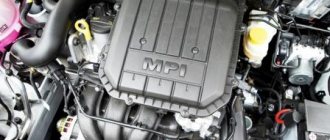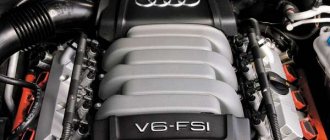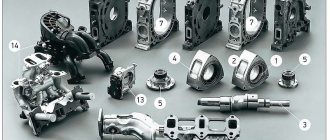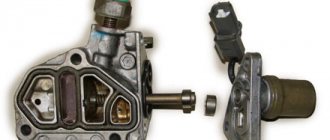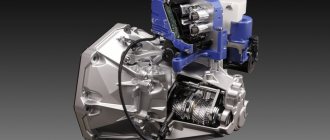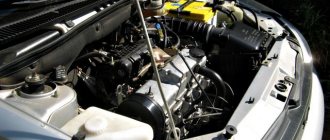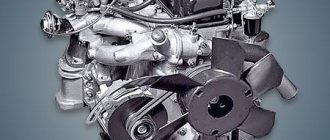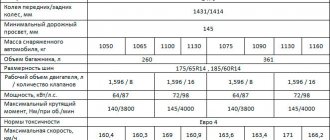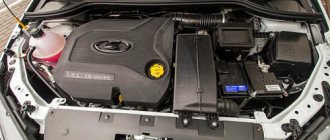The list of various engine characteristics always includes a division of power units into so-called naturally aspirated and supercharged engines. Both gasoline and diesel power units can be supercharged or naturally aspirated. It should be added that modern diesel engines in cars are almost always turbocharged (turbodiesel). Next, we will look at what a naturally aspirated engine is and how it differs from a supercharged engine, as well as the advantages and disadvantages of naturally aspirated engines.
We also recommend reading an article about what turbocharging is and why internal combustion engines of this type are much more powerful compared to simple atmospheric counterparts with the same displacement.
The principle of operation of an atmospheric engine
Any internal combustion engine operates by igniting the fuel in the cylinders, which is provided by oxygen. The combustion process of the mixture, created in the required proportions by a carburetor or injector, generates energy that drives the car engine mechanisms. In the case of a gasoline engine, the air-fuel mixture is a proportion of gasoline and oxygen in a ratio of 1:14. To understand in more detail what an atmospheric engine in a car is, and to understand exactly how it performs its functions, let’s consider the process of supplying air in stages. First, let's define the fuel mixture supply devices used:
- Carburetor. The device is a simple design that ensures the process of mixing fuel with air mechanically, while adjusting the supply requires careful adjustment. The carburetor consists of a float and air chambers connected to each other by a spray tube. Fuel is supplied to the float chamber by means of a fuel pump; a needle filter and float ensure the supply of fuel. The mixing chamber contains a diffuser, atomizer and throttle valve. The movement of the pistons causes a vacuum, due to which air and gasoline are sucked in, ensuring the functioning of the engine. The mixture is supplied regardless of the engine operating mode, resulting in high fuel consumption and high exhaust levels.
- Injector (nozzle). The fuel supply control system in this case is more advanced. The process is controlled by an electronic system (microcontroller), which controls the calculation of fuel portions by analyzing readings from vehicle sensors. The fuel supply does not depend on the operating mode of the engine, as is the case with a carburetor, and is performed automatically using injectors; they, in turn, have different connection options: single-point (mono-injection), multi-point (distributed) and direct (direct injection). Pressure stability is ensured by a special valve that discharges excess fuel. Thus, fuel is supplied in clearly metered volumes, which results in savings, reduced emissions and high engine performance. These factors contributed to the great popularity of engines equipped with injectors, and today they have practically forced carburetor engines out of the market.
Operating principle of an atmospheric engine:
- suction of air flow from the atmosphere by moving pistons;
- creating an air-fuel mixture by mixing oxygen with fuel;
- supplying the mixture to the combustion chamber;
- release of energy due to ignition;
- pressure on the piston;
- transmission of rotation to the crankshaft.
Thus, the vehicle is set in motion, the continuity of which is ensured by stable pressure in the cylinders and a regular supply of fuel. The air pressure transmitted to the engine is one atmosphere. The definition of atmospheric engines includes both gasoline and diesel models, in which atmospheric pressure is present in the combustion chamber when the mixture is ignited. Despite the design features and the difference in the type of fuel used, the operation of the units is based on the same operating principle. There are no special devices for forcing air flows with any version of an atmospheric internal combustion engine.
Classification of atmospheric engines
An atmospheric engine is an internal combustion engine into which air enters through filters, where it is mixed with fuel. The resulting mixture enters the combustion chamber, ignites and sets the pistons in motion, thanks to which the entire operation of the car is maintained.
Internal combustion engines that convert heat energy from fuel combustion into mechanical energy of movement are divided into three groups:
- diesel;
- gas;
- gasoline.
Back in the 19th century, the first gasoline engine was created, which underwent many changes during its existence. It has found wide application in the automotive industry along with the diesel unit. Gas is used only as an additional element to a gasoline engine.
According to the method of fuel supply, all atmospheric units are classified into 2 types:
- carburetor;
- injection.
The carburetor is a component of the engine power supply system. In it, fuel is mixed with a certain part of the air, forming an air-fuel mixture. The resulting mixture in the most appropriate quantity and composition is supplied to the cylinders of the engine itself.
An injector or special nozzle is an electronic-mechanical unit in a car whose task is to spray fuel by direct injection directly into the cylinder or into the intake manifold.
The injector outperforms the carburetor in terms of efficiency. A carburetor unit consumes more fuel, the content of harmful substances in the exhaust increases, since the fuel burns less fully. System management requires manual configuration.
Atmospheric device
How the engine works can be seen using the example of a four-stroke naturally aspirated one. Based on their functions, motor parts are divided into approximately 4 groups:
- To ensure the intake and ignition of fuel-air mixtures. This group includes the cylinder head and valve mechanism.
- Parts to ensure compression of the air-fuel mixture. This group consists of pistons, piston rings, cylinder block, valve.
- To transmit motor energy. The group contains connecting rods, a crankshaft, bearings and flywheels; they can be purchased here: /uzp.net.ua/ru/podshypnyky/.
- Parts for producing spark flashes. The group is filled with spark plugs and distributors.
The interaction of these engine parts ensures the main rotation of the wheels.
Cylinder head
This is the main part of the engine, located directly above the cylinder block. It is constantly exposed to combustion gases that have high temperature and pressure. The part is made of sheet iron or aluminum alloy with high-strength and high-temperature additives.
Valves and related parts
Modern four-stroke engines have 4 valves for each cylinder: 2 intake and 2 exhaust. To ensure efficient intake, the intake valve has a larger diameter than the exhaust valve. They are made from high temperature nickel or chrome steel.
Each valve has accompanying parts: a seat and a spring, which is spiral and creates close contact with the seat, preventing gas leakage. Typically, engines use one spring, but in some types 2 are installed for each valve.
When the valve is closed, the seat is in close contact with the valve surface to ensure a tight combustion chamber.
The cylinder block forms the frame of the engine. Together with the pistons, the cylinder block plays an important role in ensuring that compression and combustion pressures are overcome. To minimize wear of parts and gas leaks, the inner surface of each cylinder is separated by high pressure chrome plating.
The cylinder hole is made circular. However, the upper part of the cylinder and piston suffers from wear due to high pressure and temperature. Later, the gap between the piston rings and the cylinder increases, leading to compression losses.
Motor piston
The part moves up and down in the cylinder under the influence of pressure generated by explosions of the fuel-air mixture. In this case, the piston rotates the crankshaft through the piston pin and connecting rod. The cross-section of the piston is not a perfect circle: the diameter in the direction of the piston pin is made slightly smaller to allow thermal expansion to escape.
The piston head becomes much hotter and expands more than the skirt. To compensate for the difference in thermal expansion, the diameter of the piston at the top is made smaller than at the bottom. The rings prevent leakage under compression pressure of the mixture through the gap between the cylinder and the piston. Typically each piston has 3 rings.
Unit connecting rod
It connects the piston to the crankshaft so that the vertical movement of the piston is converted into rotational movement of the crankshaft. Since the connecting rod is subject to continuous forces of compression and tension, it must be quite strong and well supported to withstand these loads.
Crankshaft
This part converts the linear motion of each piston into rotational motion through the connecting rod. It consists of crankpins that transmit the force of the pistons and shaft, crankpins that regulate the rotation of the shaft, and balancing weights that ensure good, balanced rotation of the shaft.
The crankshaft rotates at high speed, subject to heavy loads from the pistons, so it must be quite strong and secured, as well as well balanced both statically and dynamically.
Atmospheric power unit - pros and cons
What is an atmospheric engine? This is an internal combustion engine in which air supplied through the carburetor takes part in the formation of a combustible mixture and which, when ignited, produces energy capable of driving the engine. But you should not delve into the working principle of such units in detail; this, after all, is not the purpose of this content. A car enthusiast who chooses a vehicle with a naturally aspirated engine, and is still looking at a turbocharged engine, should know about the pros and cons of the power unit that will be installed on his car.
There are 3 undeniable advantages of an atmospheric engine.
Long engine life
You can operate atmospheric units, and it doesn’t matter what they run on, gasoline or diesel fuel, for tens and tens of thousands of km. mileage
There are cases when naturally aspirated engines lasted 300-500 thousand km, even without major repairs. There were even examples of such “survivable” engines that were installed as “native” ones on other cars.
Reliability and simplicity
This kind of record performance can be explained by the relative simplicity of their design and their neutral attitude to the quality of fuel and motor oil. Such a power unit can easily “digest” even the worst fuel. Of course, if you often refuel with such “bad stuff,” then the naturally aspirated engine may fail, although restoring it will cost less than resuscitating a turbocharged engine.
High maintainability
In addition to its structural simplicity, the atmospheric unit also has high maintainability. If it fails, it can be repaired for less money than a turbocharged engine. But with all the advantages, naturally aspirated units have their disadvantages. One of them is heavy weight and less power than a turbocharged engine. In addition, a vehicle with an atmospheric engine is much inferior in dynamics to a turbocharged one.
Improved traction installation
Sometimes, after driving a car, the owner wants to get more power and wonders whether it is possible to install a turbine on a naturally aspirated engine. To improve overclocking dynamics, this solution to the problem is acceptable. In practice, completing the task is difficult; knowledge, experience, and most importantly, a comprehensive approach are required. It will not be possible to install a turbine on your own; for this, a series of calculations are performed. First, they measure how much air is placed in the chamber, at what speed the motor is fed and filled. The calculations carried out affect the behavior of the engine in the future. In addition, some installations are not suitable for connecting a turbine compressor; in this case, mechanical turbines with a permanent drive are used to improve performance.
Important! Remember, if, before installing a turbine on an atmospheric engine, you carry out incorrect calculations and selection of mechanisms, then in the future it will be difficult to predict the behavior of the engine. Perhaps the money and effort will be wasted, and the motor will become unusable.
Other ways to improve engine power:
- Boring of the frame to a larger volume of chambers;
- Installation of the pipe;
- Installation of other valves and camshafts;
- Installation of improved filter elements;
- Installing a higher power pump;
- Reducing losses due to friction of air masses.
Application of the above measures will improve power indicators by 40%. In addition, another method is used when the motor is chipped. This improvement affects the software part of the unit and gives a power increase of 15%. The procedure is carried out at special stations, as it requires equipment and skills.
Pros and cons of turbocharged engines
Like any device, a turbocharged engine has certain advantages and disadvantages. The list of advantages of this engine includes the following points:
- A significant increase in engine power and torque by 70% compared to its naturally aspirated counterpart, which is the main goal of the design change of the unit.
- Reducing gasoline or diesel fuel consumption per unit of power.
- Improved environmental characteristics of exhaust gases due to the operation of a turbocharger, as well as the most complete combustion of the air-fuel mixture in the cylinders.
- Reduced noise levels.
- The versatility of the design of a turbocharged engine, both gasoline and diesel, allows it to be installed on cars of any brand. Installation of a power unit of this type is possible using the same fasteners.
The main disadvantages of these motors include the following operational disadvantages:
complexity of the design, creating difficulties during operation;
- it is necessary to constantly change the engine oil poured into both the engine crankcase and the turbine, and also regularly monitor its quality;
- frequent replacement of air and oil filters;
- increased requirements for the quality of gasoline and diesel fuel, which must have a high degree of purification;
- increase in overall fuel consumption;
- high cost of repairing a turbocharged engine;
- the need to run the engine at idle speed before shutting down in order to extend the life of the turbine itself.
When assessing all the pros and cons, the conclusion suggests itself that the efficiency and power of turbocharged engines is significantly higher than naturally aspirated power units with a similar volume. Owners of cars with such an engine need to carefully monitor the engine of their car.
Only with this attitude is the turbocharged power unit able to provide high efficiency in all modes under all road conditions.
Advantages and disadvantages
Many motorists still choose atmospheric units due to their advantages:
- the simplicity of the structure ensures ease of maintenance, the ability to fix the problem yourself and low costs;
- simple operating principle;
- low oil consumption: about 200−500 g per 10 thousand km;
- oil change after 15 thousand - 20 thousand km;
- copes well with low-quality fuel;
- quick engine warm-up;
- ability to travel over 500 thousand km without major repairs.
Among the disadvantages of the unit, the most significant compared to a turbocharged engine are:
- higher fuel consumption;
- lower power, dynamism and environmental friendliness.
The development of promising atmospheric engines is moving towards improving the working process, increasing the compression ratio and controlling valve timing, using fuel injection into the cylinders, reducing mechanical losses and costs for auxiliary equipment.
Which engine is better to choose a car with?
Both types of motors have both their advantages and disadvantages. Therefore, it is impossible to say for sure which one is better. If you are a fan of aggressive driving, quick starts from a standstill, love drive and are ready for significant maintenance costs, then the choice is clear - a car with a turbocharged engine. However, when leaning towards such a choice, you must remember that the engine of your vehicle (and especially the turbine) will “live” much less than its atmospheric counterpart. In addition, you must be sure that in your region you can easily purchase high-quality fuel, as well as special synthetic oils.
If your driving style is characterized by calm, forethought and caution, and you are also a practical and frugal person, then the excess power of a turbocharged engine is simply not gentle for you. But the reliability, ease of maintenance and durability of an atmospheric engine will significantly save the cost of its daily operation
Is the naturally aspirated engine a thing of the past?
At the beginning of the article we talked about increasingly stringent emissions standards. They are the reasons why traditional naturally aspirated engines are being driven out of the automotive industry.
This is confirmed by the fact that many popular brands have already completely abandoned them. Whether we're talking about cars for everyone (like BMW, Mercedes or Alfa Romeo) or luxury cars (like Rolls-Royce, Maserati, Bentley), most of them no longer produce naturally aspirated engines.
When you go to a car showroom today, don't be surprised by the fact that the powerful family car has a 1.5 liter engine, but with two turbochargers.
Naturally aspirated Saab engine. Photo by: Mr. Choppers / Wikimedia Commons / CC BY-SA 3.0
If you continue to use a naturally aspirated engine, you will run into a real problem. You have to search among the few Korean or Japanese brands (Toyota, Mazda, Lexus). In addition, there may be separate models of Ford (Mustang), Lamborghini or Porsche...
... But, as you can see, these are mainly supercar models.
The only convenient solution in this case is to go for old, used cars. However, the problem here is that they will not match the characteristics of the new models.
What is a turbocharged engine and what does it mean?
You already know that in nature there are conventional atmospheric engines, MPI engines with distributed fuel injection. The same aspirated engines, but the designers messed around with additional injectors for each cylinder (not to be confused with direct injection). All of them work due to air suction by the power unit itself. The pressure in the intake manifold is atmospheric, that's why they are called that.
In the late 19th and early 20th centuries, many engineers thought about increasing power by compressing the air supplied to the combustion chambers. A certain Alfred Büchi patented the principle of turbocharging in 1911. For the first time, he was able to force air into the internal combustion engine and increase its power by 120%. Since then, the era of turbocharged engines began.
Let's finish with history and move on to physics. Fuel combustion in the cylinder chambers occurs with the presence of air in them. To increase power, you need to supply more gasoline to them. But a large amount of “fuel” cannot ignite without an increased amount of oxygen, which means it also needs to be increased. And its increase is possible only by increasing the working volume of the cylinder. Until a certain time this was the case. Engine sizes increased exponentially - three, four, six liters in order to increase horsepower.
They had to learn how to attach a turbine or compressor to engines with a small displacement. By the way, there is a difference between these two concepts; I wrote about this in detail in the article “Differences and advantages of a compressor and a turbine for a car.” Therefore, these two definitions should not be confused. The purpose is the same, but the principles of operation are different.
What does a turbine provide?
It increases the power of the power unit. Let it be a gasoline or diesel internal combustion engine. Power and torque per cubic centimeter of useful cylinder volume increases significantly in comparison with “aspirated” engines.
In addition to increased horsepower, we get fuel savings and, accordingly, less harmful emissions. Environmentalists are ecstatic. It has its drawbacks, more on them later. The problem of “turbo lag” has appeared - when, when you sharply press the gas pedal at low speeds, the car growls, but does not move. Pickup begins when the engine spins up to 2500-3000 rpm. This is due to the operating characteristics of the turbine.
Naturally Aspirated Engines vs. Today
Today's market specifics are not conducive to the creation of engines that produce power in the traditional way. Government agencies regularly tighten exhaust emission limits, increasing demand for cars that consume less fuel.
In such conditions, it is difficult to imagine future versions of V8 engines with power larger than an Olympic swimming pool.
Again, turbocharging is becoming more and more common among manufacturers as this type of engine allows them to increase the efficiency of the vehicle without sacrificing its performance. However, some call it "primitive" power amplification.
Is it really?
To answer this question, we first need to clarify what is a naturally aspirated engine and a turbo engine? Read and find out.
About reliability
Which engine is more reliable - naturally aspirated or turbocharged? Compared to the first, the turbocharged engine is less reliable. This is due to a more complex design. You also need to understand that all parts in such a motor are subject to high loads. Indeed, with the same volume and design, this unit produces great performance. This clearly affects the shared resource. You should know that a turbocharged engine operates at elevated temperatures. Therefore, you need to check the oil more often and monitor the condition of all filters. The slightest problem with them affects performance and fuel consumption.
Unfortunately, the service life of such motors will always be lower. This is especially true for gasoline engines. A striking example of this is turbocharged engines from the Volkswagen-Audi concern.
The service life of such motors, even with timely maintenance, does not exceed two hundred thousand kilometers. Diesel engines are also available. They last a little longer. But the turbine will make itself felt earlier anyway. And then the owner will have to prepare for serious capital investments.
Now about the renovation. Repairing the most critical component (turbine) is not so easy. If it shows characteristic signs, diagnostics and troubleshooting should be performed. This is best left to qualified specialists. The repair itself consists of replacing the turbine cartridge. This is the most popular recovery method. You can go another way - install a previously used turbine from disassembly. Although this option is dangerous, because no one guarantees how long it will last, what its actual mileage is and under what conditions it was operated. However, all operations related to the repair and diagnosis of this element have their own difficulties. This is reflected in the final cost. Atmospheric engines in this case are much simpler. Since there is no turbine, there is nothing to repair here.
We also note that the operation of a turbocharged car has its own characteristics. For example, after aggressive driving, you should not immediately turn off the engine. You need to give it the opportunity to idle so that the turbine cools down.
